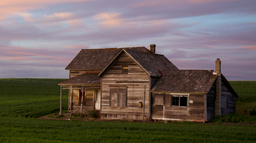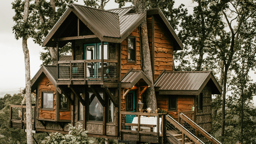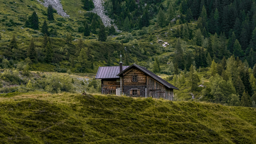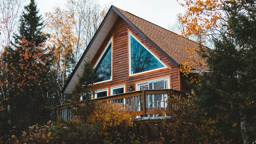
Cabins often require unconventional heating solutions. If your cabin has classic exposed log walls, this architectural style prevents you from installing a modern heating system with ductwork and insulation materials. That means you need to find an alternative heating device that compliments your cabin’s classic design.
Check out the five most popular cabin heating systems and see which option is best for your personal needs.
1. Wood Stove
The wood stove is the go-to heating solution for traditional log cabins. Just one stove can produce enough heat for the entire house as long as it stays between 500 and 800 degrees Fahrenheit and you maintain a healthy supply of firewood. You can keep a steady smolder going all winter long and have no issue controlling your cabin’s temperature.
There are two main types of wood stoves:
- Catalytic: Catalytic wood stoves have a combustor plate that burns away more gasses and particulate matter, which causes the stove to release more heat and fewer harmful emissions. However, you need to clean the plate every one or two weeks and replace it after a few seasons.
- Non-catalytic: Non-catalytic wood stoves don’t burn as efficiently as catalytic stoves, but they’re cheaper and easier to maintain. All you need to do is periodically remove the ashes and clean the chimney.
Large wood stoves can cost upwards of $5,000 plus installation fees for both types, but you will save money in the long run. All wood stoves are made of stone, steel or cast iron, so they’re built to last a lifetime. Additionally, using wood as your main fuel source is much more cost-effective than using fossil fuels or electricity.
The only major drawback of wood stoves is the amount of smoke they produce, but newer models don’t have this problem. While older models emit 15-30 grams of smoke per hour, you can get an EPA-certified wood stove that only releases 4.5 grams per hour. Wood stoves are highly efficient and durable, making them the best all-around option for cabin heating.
2. Pellet Stove
Pellet stoves burn compacted pellets instead of regular firewood. Although they produce less heat than traditional wood stoves, they are the cleanest residential heating appliances that rely on solid fuel. Most EPA-approved models fall into the 70%-83% efficiency range and almost rival modern heating systems, which hover around 90% fuel efficiency.
Most pellet stove models cost between $1,700 and $3,000 plus installation fees. The main reason for the lower prices is the widespread fuel availability. Pellet stoves burn small chunks of wood, nutshells, corn kernels and other types of biomasses. They can also capture ash particles and filter gasses more efficiently thanks to the smaller fuel.
Most pellet stoves have storage containers and automated feeding devices, ensuring that you only burn as much fuel as necessary. These features require electricity, but they will only add about $9 per month to your electricity bill under normal usage. Overall, pellet stoves are great options for eco-friendly and cost-effective heating.
3. Gas Stove
While wood stoves and pellet stoves seem more fitting for a cabin, gas stoves are also viable options. In fact, some models look exactly the same as traditional stoves, replicating their rustic charm without the constant need for firewood or pellets. This heating system might be the perfect option if your property has a natural gas line.
If you don’t have a natural gas line, you can also use a gas stove that runs on liquid propane. Propane burns cleaner than natural gas and is readily available at local gas stations and home improvement stores. Propane also doesn’t expire, which means you can stockpile as much as you want. You just need to inspect the tanks for leaks, and no other maintenance is required.
4. Steam Boiler
Steam boilers are largely used for commercial applications in large buildings, but they’re also great options for your cabin. They don’t require any external energy sources to send steam throughout the building because it naturally flows from room to room. Heat from water vapor is also the cleanest heat you can find, giving steam boilers another advantage.
Your only maintenance responsibility is to monitor the boiler’s water conditions. Most boilers come with a low water cut-off system (LWCS) that automatically shuts off the boiler when the water starts to run out. You must use the LWCS and conduct frequent “blowdowns” — emptying and refilling the tank so you can check for damage or blockages.
5. Solar Thermal Panels
Solar thermal panels are increasingly popular heating systems for cabins and other off-the-grid homes. Instead of converting sunlight into electricity, these panels convert sunlight into a clean heat source that naturally replenishes itself. Solar energy heats up the panels, which in turn heats up many gallons of water inside the solar storage tank.
The storage tank then circulates the hot water throughout the house through a heat exchanger, much like a regular hot water heater. Most thermal panels have a two-tank design to store water at a low temperature and high temperature. If you’re looking for an eco-friendly heating system that doesn’t require any fuel, solar thermal panels could be the perfect solution.
Factors to Consider When Choosing Your Heating System
Before choosing a heating system, you must consider several factors about your cabin’s location and design. If you live in an area with harsh winters, heat production should be a higher priority than energy efficiency. That means a wood stove or pellet stove might be the best choice even though solar thermal panels are more eco-friendly.
Your location also affects the availability of fuel. If you live in a heavily forested area, you will never run out of fuel for a classic wood stove. Similarly, a gas stove might serve you better if you live near a store that sells propane tanks and don’t have consistent access to firewood.
You must also consider a handful of design features to determine the best placement for your heating system. All these factors can impact heat distribution and affect how warm certain rooms will be:
- Pre-existing insulation, if any
- Ceiling height
- Room layout
- Flooring materials
- Number of doors and windows, plus their locations
- Proximity to bedrooms, bathrooms and kitchen
You should consult a professional to inspect your cabin’s layout before making a final decision. They will help you find the most practical location for your new heating system and recommend the most ideal model.
Keep Your Cabin Cozy
One of the main appeals of living in a cabin is the warm and cozy atmosphere that it provides during the winter months. If you want to maintain this atmosphere, you need to choose the right heating system. Start by weighing these options and considering your cabin’s unique features to determine the best method to keep that cozy feeling.










